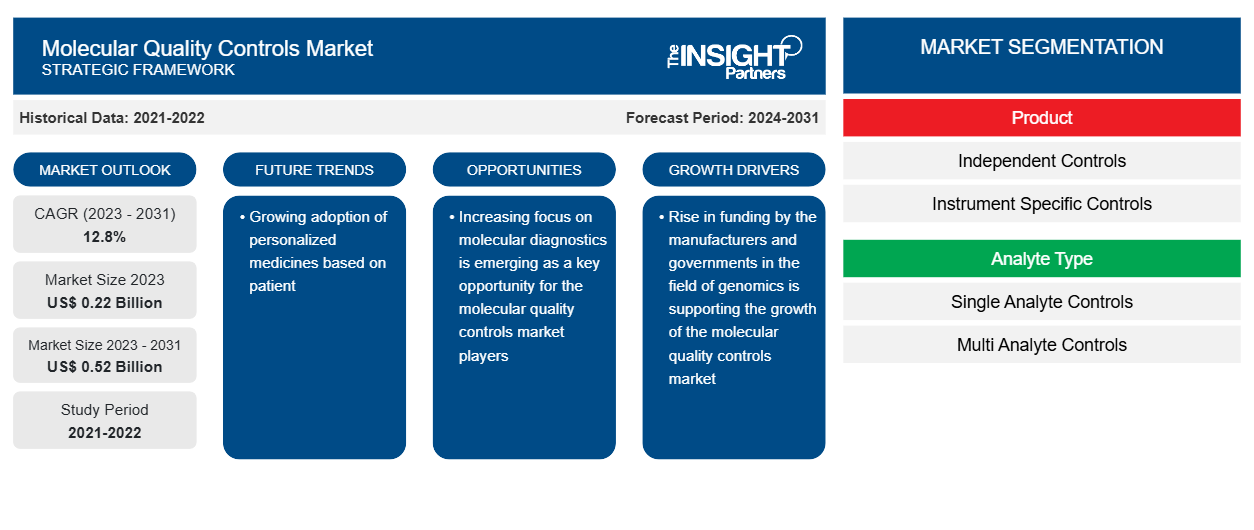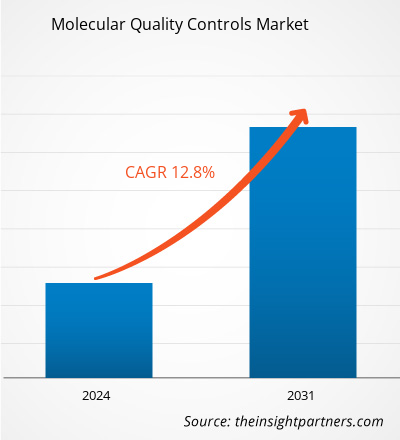The molecular quality controls market size is projected to reach US$ 0.52 billion by 2031 from US$ 0.22 billion in 2023. The market is expected to register a CAGR of 12.8% during 2023–2031. Burgeoning demand for personalized medicines will likely remain a key trend in the market.
Molecular Quality Controls Market Analysis
Factors such as growing funds for genomics and increasing prevalence of genetic diseases fuel the growth of the market. Furthermore, a rise in focus on molecular diagnostics is emerging as a key opportunity for the molecular quality control market players.
Molecular Quality Controls Market Overview
Genome sequencing was restricted to the research facilities a few years back. However, it has now become one of the standard techniques in clinical practices. As per the study ‘Integrating Genomics into Healthcare’, over the next few years, the healthcare sector is expected to generate genomic data of over 60 million patients. The growing implementation of genomic sequencing in healthcare systems is supported by substantial government investments, totaling over US$ 4 billion in at least 14 countries. The UK announced the world’s largest genome project as a part of a 200 million public-private collaboration between charitable organizations and pharmaceutical companies.
Customize This Report To Suit Your Requirement
You will get customization on any report - free of charge - including parts of this report, or country-level analysis, Excel Data pack, as well as avail great offers and discounts for start-ups & universities
Molecular Quality Controls Market: Strategic Insights

-
Get Top Key Market Trends of this report.This FREE sample will include data analysis, ranging from market trends to estimates and forecasts.
Molecular Quality Controls Market Drivers and Opportunities
Increasing Prevalence of Genetic Diseases
Since molecular quality controls facilitate result interpretation, they are employed in the detection of genetic disorders. An additional whole or partial copy of chromosome 21 is the resultant aberrant cell division that produces the genetic disease known as Downs syndrome. According to the US Centers for Disease Control and Prevention (CDC), around 6,000 babies in the US are born with Down syndrome each year. Prenatal testing for Down syndrome is rising nationwide as a result.
Two genes, BRCA1 (breast cancer gene one) and BRCA2 (breast cancer gene two), are mutated in the majority of hereditary instances of breast cancer. According to the American Cancer Society, faulty genes that are passed on from parents to their offspring account for 5% to 10% of occurrences of breast cancer that are hereditary. Genetic testing for hereditary breast cancer is becoming more popular as breast cancer awareness grows.
Rise in Adoption of Molecular Diagnostics
Molecular diagnostics methodologies are used to detect disturbances between specific sequences in DNA or RNA. The irregularities such as single nucleotide polymorphism (SNP), deletions, rearrangements, and insertions lead to various diseases—such as infectious diseases, cancer, viral diseases, and sexually transmitted diseases (STDs).
As per the Flu Facts and Statistics report, during 2017-2018, there were around 31.4 million outpatient visits due to flu. It also mentioned that 5-20% of the US population gets flu every year. Furthermore, according to the National Cancer Institute, in 2020, around 1,806,590 new cases of cancer will be diagnosed in the US, with an estimated death count of 606,520. The number of people who have cancer is expected to rise to 19 million by 2024. Such high prevalence of infectious diseases and increasing incidence of cancer lead to high traction toward molecular diagnostics, as it is capable of diagnosing diseases with high specificity, further paving the way for treating patients with precision medicine.
Molecular Quality Controls Market Report Segmentation Analysis
Key segments that contributed to the derivation of the molecular quality controls market analysis are product, application, and end user.
- Based on product, the molecular quality controls market is segmented into independent controls and instrument specific controls); analyte type (single analyte controls and multi analyte controls). The independent controls segment held a most significant market share in 2023.
- Based on application, the molecular quality controls market is segmented by infectious diseases, oncology, genetic testing, other applications. The infectious diseases segment held a largest market share in 2023.
- Based on end users, the molecular quality controls market is segmented by clinical laboratories, hospitals, ivd manufacturers & contract research organizations, academic & research institutes, other end users. The clinical laboratories segment held a largest market share in 2023.
Molecular Quality Controls Market Share Analysis by Geography
The geographic scope of the molecular quality controls market report is mainly divided into five regions: North America, Asia Pacific, Europe, Middle East & Africa, and South & Central America.
In North America, the U.S. is the most significant molecular quality control market. The increasing investments and rising funds dedicated to manufacturing companies as well as academic and research institutes for the development of cancer medicines, the growing geriatric population, infectious disease, and other therapeutics are some of the major driving factors.
Diagnostics based on NGS are generally expected to guide care selection in the future to improve patient outcomes. According to the National Cancer Institute, in the United States, an estimated 1,806,590 new cases of cancer will be diagnosed in 2020, with 606,520 people dying from the disease. Similarly, according to The Leukemia & Lymphoma Society (LLS), an estimated 178,520 people in the United States were diagnosed with leukemia, lymphoma, or myeloma in 2020. As a result, the factors mentioned above would boost market growth in the forecasted timeframes.
Molecular Quality Controls Market Regional Insights
The regional trends and factors influencing the Molecular Quality Controls Market throughout the forecast period have been thoroughly explained by the analysts at The Insight Partners. This section also discusses Molecular Quality Controls Market segments and geography across North America, Europe, Asia Pacific, Middle East and Africa, and South and Central America.
Molecular Quality Controls Market Report Scope
| Report Attribute | Details |
|---|---|
| Market size in 2023 | US$ 0.22 Billion |
| Market Size by 2031 | US$ 0.52 Billion |
| Global CAGR (2023 - 2031) | 12.8% |
| Historical Data | 2021-2022 |
| Forecast period | 2024-2031 |
| Segments Covered |
By Product
|
| Regions and Countries Covered |
North America
|
| Market leaders and key company profiles |
|
Molecular Quality Controls Market Players Density: Understanding Its Impact on Business Dynamics
The Molecular Quality Controls Market is growing rapidly, driven by increasing end-user demand due to factors such as evolving consumer preferences, technological advancements, and greater awareness of the product's benefits. As demand rises, businesses are expanding their offerings, innovating to meet consumer needs, and capitalizing on emerging trends, which further fuels market growth.

- Get the Molecular Quality Controls Market top key players overview
Molecular Quality Controls Market News and Recent Developments
The Molecular Quality Controls Market is evaluated by gathering qualitative and quantitative data post primary and secondary research, which includes important corporate publications, association data, and databases. A few of the developments in the molecular quality controls market are listed below:
- Abbott and Personalis, Inc. have entered into a collaborative agreement to develop and distribute liquid biopsy controls intended for use in next-generation sequencing (NGS) research. The objective of this collaboration is to enhance the precision and dependability of liquid biopsy procedures for the detection and tracking of cancer. (Source: Abbott, Company Website, May 2024)
- New QuantiTect viral load controls for cytomegalovirus, hepatitis B virus (HBV), and SARS-CoV-2 are now available, according to Qiagen. These controls address the rising requirement for accurate viral infection monitoring in clinical settings. (Source: Qiagen, Company Website, January 2024)
Molecular Quality Controls Market Report Coverage and Deliverables
The “Molecular Quality Controls Market Size and Forecast (2021–2031)” report provides a detailed analysis of the market covering below areas:
- Molecular quality controls marketsize and forecast at global, regional, and country levels for all the key market segments covered under the scope
- Molecular quality controls markettrends as well as market dynamics such as drivers, restraints, and key opportunities
- Detailed PEST/Porter’s Five Forces and SWOT analysis
- Molecular quality controls marketanalysis covering key market trends, global and regional framework, major players, regulations, and recent market developments.
- Industry landscape and competition analysis covering market concentration, heat map analysis, prominent players, and recent developments for the molecular quality controls market
- Detailed company profiles
Frequently Asked Questions
Which region dominated the molecular quality controls market in 2023?
What are the driving factors impacting the mesotherapy market?
What are the future trends of the quality control market?
Which are the leading players operating in the quality controls market?
What is the expected CAGR of the quality controls market?
- Historical Analysis (2 Years), Base Year, Forecast (7 Years) with CAGR
- PEST and SWOT Analysis
- Market Size Value / Volume - Global, Regional, Country
- Industry and Competitive Landscape
- Excel Dataset
Recent Reports
Testimonials
Reason to Buy
- Informed Decision-Making
- Understanding Market Dynamics
- Competitive Analysis
- Identifying Emerging Markets
- Customer Insights
- Market Forecasts
- Risk Mitigation
- Boosting Operational Efficiency
- Strategic Planning
- Investment Justification
- Tracking Industry Innovations
- Aligning with Regulatory Trends





















 Get Free Sample For
Get Free Sample For